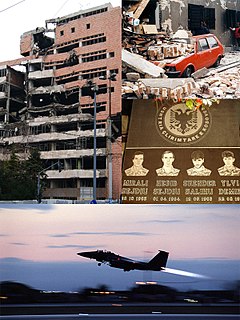
The Kosovo War was an armed conflict in Kosovo that started in late February 1998 and lasted until 11 June 1999. It was fought by the forces of the Federal Republic of Yugoslavia, which controlled Kosovo before the war, and the Kosovo Albanian rebel group known as the Kosovo Liberation Army (KLA), with air support from the North Atlantic Treaty Organisation (NATO) from 24 March 1999, and ground support from the Albanian army.
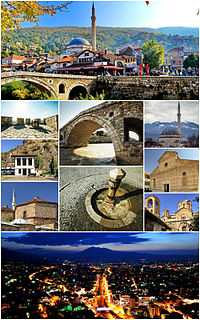
Prizren is a city and municipality located in the Prizren District of Kosovo. According to the 2011 census, the city of Prizren has 85,119 inhabitants, while the municipality has 177,781 inhabitants.
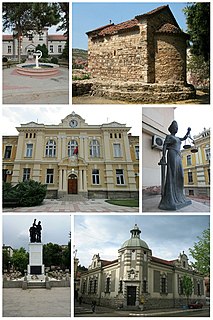
Prokuplje is a city and the administrative center of the Toplica District in the southern Serbia. According to 2011 census, the city urban area has a population of 27,333 inhabitants, while the administrative area 44,419 inhabitants.
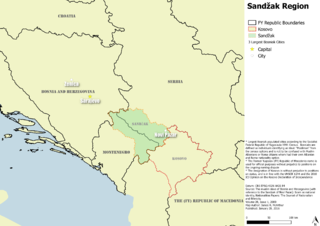
Sandžak or Sanjak is a historical geo-political region, now divided by the border between Serbia and Montenegro. The name Sandžak derives from the Sanjak of Novi Pazar, a former Ottoman administrative district. Between 1878 and 1909 the region was placed under Austro-Hungarian occupation, following which it was ceded back to the Ottoman Empire. In 1912 the region was divided between the kingdoms of Montenegro and Serbia. Serbs refer to the northern part of the region by its medieval name Raška. The most populous city in the region is Novi Pazar in Serbia.

Bujanovac is a town and municipality located in the Pčinja District of southern Serbia. Situated in the South Morava basin, it is located in the geographical area known as Preševo Valley. It is also known for its source of mineral water and spa town Bujanovačka banja.

Adem Jashari was one of the founders of the Kosovo Liberation Army (KLA), a Kosovo Albanian separatist organization which fought for the secession of Kosovo from the Federal Republic of Yugoslavia during the 1990s and the eventual creation of a Greater Albania.

Sjenica, is a town and municipality located in the Zlatibor District of southwestern Serbia. The population of the town, according to 2011 census, is 14,060 inhabitants, while the municipality has 26,392.

Šuto Orizari, often shortened as Šutka (Шутка), is one of the ten municipalities that make up the City of Skopje, the capital of the Republic of North Macedonia. Šuto Orizari is also the name of the urban neighbourhood where the municipal seat is found.
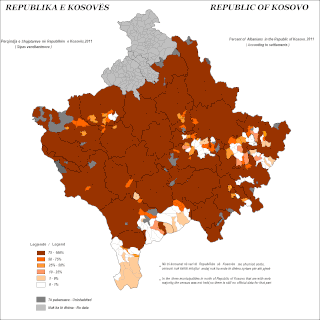
The Albanians or Kosovars, also commonly Kosovo Albanians, Kosovar Albanians or Kosovan Albanians, constitute the largest ethnic group in Kosovo.
The Serb-Montenegrin community in Albania is estimated to number ca. 2,000 to 30,000 people. In the latest census (2011), citizens had the option to declare as "Montenegrins". The population is concentrated in the region of Vraka. The community is bilingual and by majority adhere to Eastern Orthodoxy, while a minority professes Islam. Most of the community arrived in Albania during the Zogist period and between 1938 and 1948.

The Insurgency in the Preševo Valley was an armed conflict between the Federal Republic of Yugoslavia and the ethnic Albanian separatists of the Liberation Army of Preševo, Medveđa and Bujanovac (UÇPMB). There were instances during the conflict in which the Yugoslav government requested KFOR support in suppressing UÇPMB attacks since they could only use lightly armed military forces as part of the Kumanovo Treaty that ended the Kosovo War, which created a buffer zone so that the bulk of Yugoslav armed forces could not enter.

Tabanovce is a village located in the north of the Republic of North Macedonia, at the border with Serbia, situated 8 km from the nearest town, Kumanovo.
Albanians in Serbia are an officially recognized ethnic minority living in the present-day country of Serbia.

The Attack on Prekaz, also known as the Prekaz massacre, was an operation led by the Special Anti-Terrorism Unit of Serbia on 5 March 1998, to capture Kosovo Liberation Army (KLA) fighters deemed terrorists by Serbia. During the operation, KLA leader Adem Jashari and his brother Hamëz were killed, along with nearly 60 other family members. The attack was criticized by Amnesty International, which wrote in its report that: "all evidence suggests that the attack was not intended to apprehend armed Albanians, but 'to eliminate the suspects and their families.'" Serbia, on the other hand, claimed the raid was due to KLA attacks on police outposts.

A series of war crimes were committed during the Kosovo War. Yugoslav security forces killed many Albanian civilians during the war. According to Human Rights Watch, the vast majority of the violations from January 1998 to April 1999 were attributable to Serbian Police or the Yugoslav Army. Violations also include abuses committed by Kosovo Liberation Army, such as kidnappings and summary executions of other minority races and Albanians.

Kapit is a village in the municipality of Medveđa, Serbia. According to the 2002 census, the village has a population of 253 people. Of these, 245 were ethnic Albanians, 6 were Serbs, and 2 others.

Magarevo is a village in the municipality of Bitola, Republic of Macedonia. The village is 8.29 kilometers away from Bitola, which is the second largest city in the country.

Insurgency in Kosovo emerged in 1995, following the Dayton Agreement. In 1996, the Kosovo Liberation Army (KLA) took responsibility for attacks, targeting ethnic Serb villages and Serbian governmental buildings and police stations. The insurgency led to the Kosovo War in March 1998.
The Kosovo Agency of Statistics monitors various demographic features of the population of Kosovo, such as population density, ethnicity, education level, health of the populace, economic status, religious affiliations and other aspects of the population. Censuses, normally conducted at ten-year intervals, record the demographic characteristics of the population. According to the first census conducted after the 2008 declaration of independence in 2011, the permanent population of Kosovo had reached 1,739,825, excluding North Kosovo.



















